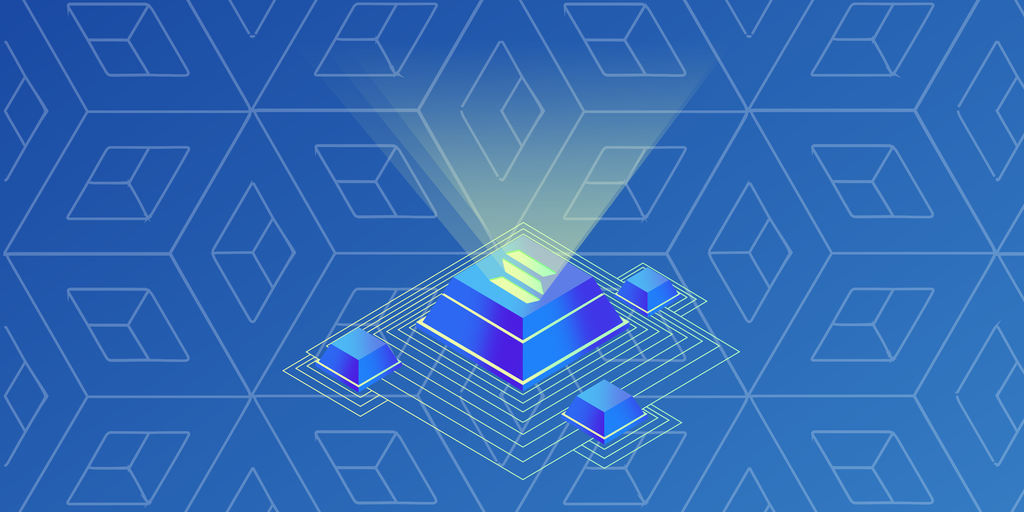
In brief
- Solana is a blockchain designed to support massively scaling decentralized applications (dapps).
- It claims a maximum throughput of more than 50,000 TPS and block times as low as 400 ms.
Decentralized applications, or dapps, are widely regarded as one of the key use cases for blockchain technology.
In the last few years, dapps have come on in leaps and bounds, with dapp developers launching everything from games to decentralized finance (DeFi) platforms on blockchain—and a concomitant explosion in user interest.
But there’s a problem. The vast majority of these dapps run on Ethereum, which has struggled to keep up with rampant demand—leading to congestion on the network and soaring transaction fees.
Now Solana, a blockchain platform that had its beginnings in 2017, is aiming to step into the breach, and succeed where Ethereum is currently struggling.
What is Solana?
Solana is an advanced open-source blockchain project that looks to leverage several breakthrough technologies to power the next generation of dapps.
The project is focused on providing a highly scalable, secure, and maximally decentralized platform that can support potentially thousands of nodes without sacrificing throughput—helping to avoid some of the challenges faced by competing systems.
It was founded in 2017 during the ICO boom and raised more than $25 million across various private and public sale rounds. The platform went to mainnet in March 2020, but is still operating as a beta release.
How does Solana work?
One of Solana’s key distinguishing features is its Proof of Stake (PoS) consensus system, which is reinforced by something known as Tower Consensus, or Tower BFT. This is a variant of a system that enables distributed networks to reach consensus despite attacks from malicious nodes, known as Practical Byzantine Fault Tolerance (PBFT).
Solana’s implementation of PBFT enforces a global source of time across the blockchain through a second novel protocol known as Proof of History (PoH). This essentially provides a chronicle of previous events on the blockchain, ensuring that there’s a common record of what happened and when for permanent reference.
Tower Consensus leverages this synchronized clock to reduce the processing power needed to verify transactions, since the timestamps of previous transactions no longer need to be computed. This helps Solana achieve a throughput that dwarfs most competitors (more on this later).
Beyond this, Solana includes a number of other innovations that help it stand out from the competition. Among these is its transaction parallelization technology, known as Sealevel. This allows for a parallel smart contracts runtime that optimizes resources and ensures that Solana can scale horizontally across GPUs and SSDs, which should help the platform scale to meet demands.
Solana also completely nixes the mempool system used by other platforms, and instead forwards transactions to validators even before the previous batch of transactions is finalized. This helps to maximize confirmation speed and boost the number of transactions that can be handled both concurrently and in parallel. This technology is known as “Gulf Stream.”
What’s so special about it?
When it comes to decentralized applications, speed matters.
Network slowdowns have been a persistent issue for the Ethereum network, leading to the emergence of multiple layer-2 solutions.
Solana’s raison d’être attempts to address precisely this. Per the project’s whitepaper, the network is theoretically capable of handling up to 710,000 transactions per second (TPS) at peak load, which would make it arguably the fastest blockchain currently operating.
In real-world scenarios, Solana is currently handling an average of 4,o00 TPS, but has reportedly reached as high as 5o,000 TPS during testing.
To put this into perspective, this is close to 1,000 times faster than Bitcoin (max throughput ~5-7 TPS) and more than 3,000 times faster than Ethereum (max throughput ~15 TPS).
Moreover, Solana claims an average block time (referred to as “slot time”) of 400 to 800 milliseconds and an average transaction fee of 0.000005 SOL (or a tiny fraction of one cent). This, combined with its massive scalability, makes it well-positioned to serve up decentralized applications that can support potentially tens of thousands of simultaneous users without buckling under the load.
Solana achieves this scalability without resorting to second-layer or off-chain technologies and doesn’t use any form of sharding—a technique that involves splitting a large database into smaller and more easily managed parts called data shards. Ethereum and Cardano are the two best-known examples of blockchain networks turning to sharding to address scalability and transaction speed issues.
Unlike some platforms, there’s no strict minimum amount of SOL required to become a Solana validator and help secure the network. The process is completely permissionless, though users will need to maintain some basic hardware to participate—namely a server that meets the minimum specifications outlined here. In total, the network currently boasts close to 2,000 validators, making it one of the more widely distributed blockchains.
What is the SOL token?
Solana, like the vast majority of smart contract platforms, features its own native gas token known as SOL, meaning all transactions and smart contract operations on the Solana blockchain will consume SOL.
The SOL token can also be staked to help support the security of the network, allowing users to earn rewards. Though the feature isn’t currently available, SOL tokens are also expected to eventually be used for the network’s on-chain governance.
Unlike Bitcoin, which has a predetermined supply cap of 21 million coins, SOL has no fixed supply limit, using a scheduled year-on-year inflation rate instead.
The SOL token was first launched on the Solana beta mainnet in March 2020 and is currently one of the top 10 largest cryptocurrencies by market capitalization.
This story was updated to clarify the nature of Tower Consensus.
This story was originally published on May 14, 2021 and was updated on November 3, 2023








